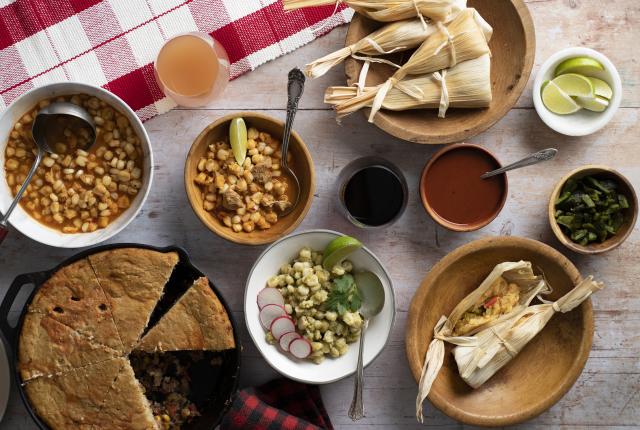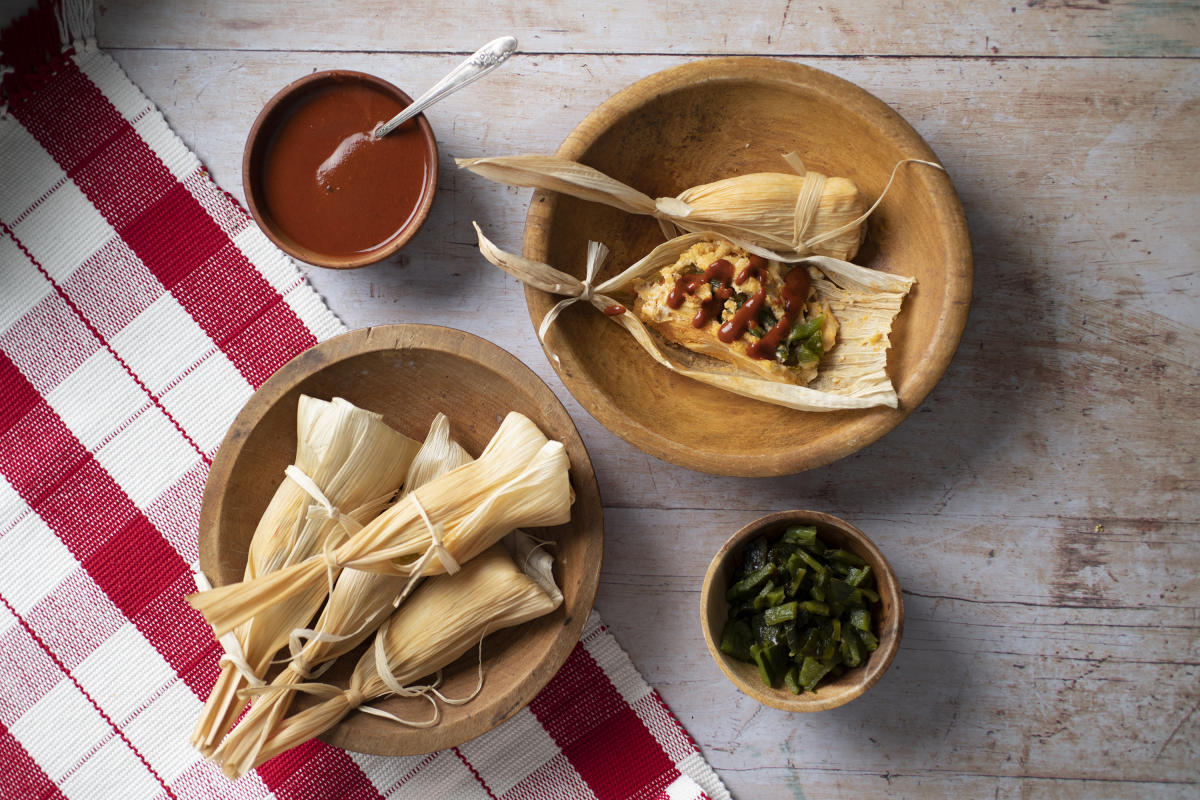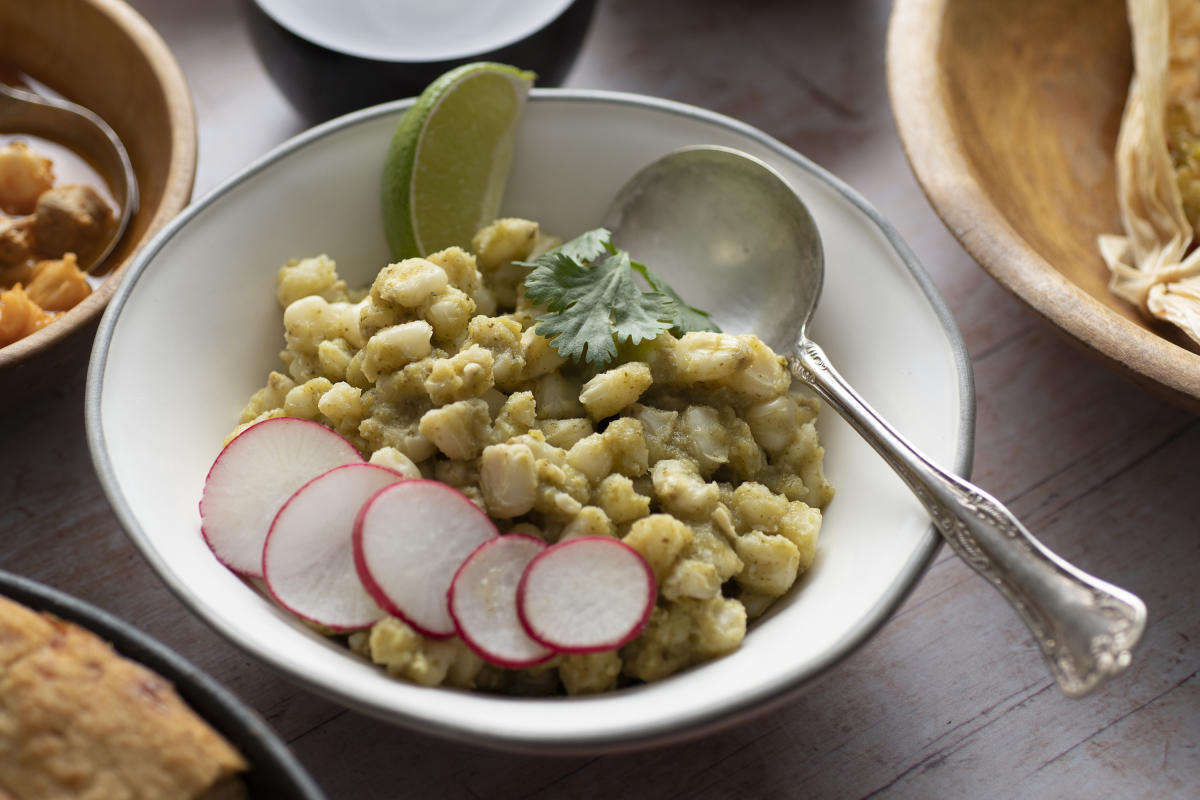FOR MOST NEW MEXICANS, “season’s eatings” comes down to two favorite dishes: tamales and posole. They’re so time-consuming to prepare that many families wait until they have a few extra helping hands on deck—which were hard to find last Christmas during the lockdown.
Those masa-and-corn-husk-wrapped delights, along with an accompanying bowlful of spicy stew, signify the coming together of family to fold, fix, and feast. Passed down from generation to generation, family recipes are re-created annually and rarely deviated from. A host of businesses throughout the state bless us by selling deliciously perfect versions of tamales, sometimes even showing up in our workplaces to market their creations. One of my favorite cartoons features a sign outside an office building: “No solicitations—except the tamale lady.”
Last year, a fellow foodie gave me a big box of vintage cookbooks to leaf through during lockdown. Among them I was delighted to discover two that were put out by New Mexico Magazine, one in 1978 and a second in 1983: The Best from New Mexico Kitchens (still in print, thanks to University of New Mexico Press) and its follow-up, More of the Best from New Mexico Kitchens. I was curious to see how food writers, chefs, and home cooks had prepared posole and tamales in the past.
The earlier book held three posole recipes, including one from Santa Clara Pueblo that would certainly feed a feast-day family—it started with 10 pounds of beef. But it lacked any red chile, which I’d always considered a staple for posole.
The other two renditions were similar in their use of pork shoulder and either chile pods or ground chile. One started with canned hominy, the other with frozen posole (my preference). Often served on Christmas Eve, perhaps after church, a stroll down Santa Fe’s Canyon Road, or a ride on the Roswell Christmas Railway, the pork-rich and chile-laden stew will stop the shivers in their tracks.
In New Mexico families, the tradition of gathering to roll tamales—called a tamalada—mirrors the holiday rituals of cookie baking and decorating among many cultures. I like to think of the strands of softened corn husks that tie a tamale into its neat little bundle as the ties that bind us as a family. Everyone, it seems, has a secret source for “the best” tamales, but it’s worth gathering friends and family for a tamalada of your own. There’s no better representation of gift giving than sending everyone home with these handmade bundles of corn, chile, and other goodies.
Experienced cooks might even be tempted to experiment with new ingredients. Years ago, Joseph Wrede, who now owns Joseph’s Culinary Pub, in Santa Fe, served me a quail-stuffed version, with goose fat substituting for the traditional lard.
Centuries-old Maya hieroglyphics show tamales painted on pots. Early Mesoamericans claim the origin, after which it spread from Mexico northward.
Derived from the Aztec word for “wrapped food,” the tamale was a staple well before Europeans arrived. Fillings ranged from sometimes unusual proteins—turkey, flamingo, frog, axolotl (a type of salamander), pocket gopher, rabbit, beans, and fish—as well as honey, fruits, and veggies. Some had no filling at all. Tree bark, grass, and banana leaves served as wrappings.
In 1893, tamales were served at the World’s Columbian Exposition in Chicago. They grew popular enough that, by the 1930s, legendary bluesman Robert Johnson included them in his song “They’re Red Hot.”
After last year’s hesitancy about large gatherings, this could be a perfect time to pull together, revive favorite traditions, and create some new ones. This season, I’m putting a spin on the classics, including an easy tamale pie and a vegan posole. Let’s give the tamale lady the day off.
If you’re too busy around the holidays to spend the time rolling tamales, this is a yummy way to cheat and still enjoy the tasty ingredients found in that time-consuming holiday treat. As I adapted this recipe from one that I found in an old cookbook, I realized it is a New Mexican version of shepherd’s pie. The original recipe called for leftover meat and leftover gravy. Fresh bison from Santa Fe’s Beck & Bulow is tastier and healthier. Or try it with ground lamb from Shepherd’s Lamb, in Chama.
FILLING
2 pounds ground bison
1 cup white onion, chopped
1 red bell pepper, seeded and chopped in ¼-inch pieces
3 garlic cloves, minced
1 cup frozen or canned corn
14.5-ounce can crushed tomatoes
1 cup New Mexico green chile, roasted, peeled, seeded, and chopped
1 tablespoon cornstarch
1 tablespoon ground New Mexico red chile
1 teaspoon cumin seed, toasted and ground
1 teaspoon salt
1 tablespoon dark brown sugar
2 teaspoons red wine vinegar
1½ cups shredded cheddar cheese
CRUST
2¼ cups masa harina
2 teaspoons baking powder
1 teaspoon salt
3 cups beef broth
½ cup melted butter
1 cup shredded Monterey Jack cheese
Makes 12 servings
INSTRUCTIONS
-
Preheat oven to 400° (recipe does not need adjusting for altitude). Choose your baking dish: two 9-inch deep-dish pie pans, one 9-by-13-inch baking dish, 12 one-cup-capacity cocottes, or a 12-to-14-inch cast-iron skillet. Coat with nonstick cooking spray and set aside.
-
Place a Dutch oven (or cast-iron skillet) over medium-high heat. Add the bison and break into small pieces with a wooden spoon. Brown the meat, then push it to the sides of the pan and add the onion, bell pepper, and garlic.
-
Cook until the onions have softened. Mix in corn, crushed tomatoes, green chile, cornstarch, red chile, cumin, salt, brown sugar, vinegar, and cheese. Stir well and turn off the heat.
-
Meanwhile, mix the masa, baking powder, and salt in a large bowl. Stir in the beef broth and butter. Whisk until smooth. Stir in the cheese. Batter will be thick but spreadable (add more broth if needed).
-
Divide and pour the meat filling into the prepared pans. (If you cooked the filling in a cast-iron skillet, you can leave it in the pan.) Pour (or spoon) the corn batter evenly over the top and spread to the edges of the pans. Spraying a spatula with nonstick spray will make this easier.
-
Bake for 35–45 minutes, until a toothpick inserted into the center of the corn batter comes out clean.
These vegan tamales will satisfy even the most dedicated meat lover. Make your accompanying red chile sauce with vegetable stock. I prefer olive oil for the roux; plant-based butter works, too.
FILLING
4 cups masa harina
2 teaspoons salt
2½ cups warm water, approximately
2 cups yam puree
1 cup olive oil
3 poblano chiles, roasted, peeled, seeded, and chopped into ¼-inch pieces
30–40 dried corn husks
Makes approximately 2 dozen tamales
INSTRUCTIONS
-
Submerge corn husks in hot water to soften.
-
In a large bowl, mix masa, salt, and water, adding just enough water to form a wet mixture that’s the texture of oatmeal.
-
In a medium bowl, use an electric mixer to whip yam puree and olive oil until light and fluffy.
-
Gently fold masa into yam puree.
ASSEMBLING THE TAMALES
-
Tear some tamale ties ⅛ inch wide from a few of the husks. Take one husk and open it with the narrow end away from you. Spread a 3-by-3-inch square of masa (about ½ cup), ¼ inch deep, leaving a one-inch border at the bottom.
-
Take 3 or 4 pieces of the poblano chile and place it in a narrow strip in the middle of the masa, going from the bottom of the tamale toward the top.
-
Using the husk, roll the masa over the chile. Open the husk, fold the bottom inch flap over the masa, and then roll the husk from right to left to close it, and twist the top. Tie the tamale at both the bottom and the top with husk ties.
TO COOK THE TAMALES
-
Place tamales vertically into a steamer. A large stockpot with a steamer insert raised above the water works well. I use a big old-fashioned canning pot. Add 3 inches of water to the pan. Place a penny in the bottom of the pan; this will rattle to warn you if you are running out of water during the steaming.
-
Cover and steam the tamales over boiling water for 30 minutes, or until masa is set and tamale loses its shiny look. Serve hot with red chile sauce.
The Shed opened in 1953 and still thrives near the Santa Fe Plaza. This recipe originally appeared in New Mexico Magazine’s 1978 cookbook The Best of New Mexico Kitchens and is reprinted with permission from UNM Press, which still publishes the book. My notes on how to modify it follow.
1 pound lean pork shoulder
2 pounds frozen posole (hominy)
Juice of one lime
2 tablespoons coarse red chile powder
3 cloves garlic
¼ teaspoon dried oregano
3 tablespoons salt
Makes 16 servings
INSTRUCTIONS
-
Cook the pork in a pressure cooker, with water to cover, for 20 minutes. Reduce pressure under cold water. Open pot and add posole, lime juice, and chile. Add water—about twice as much as the amount of posole. Cook for 45 minutes under pressure. Reduce pressure under cold water.
-
Remove the pork and cut up. Put posole, pork, garlic, oregano, and salt in a large heavy covered pot and simmer 1–3 hours, or until hominy kernels have burst and are soft but not mushy. Serve alone or as a side dish. Freezes well.
-
Note: These times are set for Santa Fe’s higher altitude. At lower altitudes, where the boiling point is higher, you may wish to try shorter cooking times at first.
MY MODIFICATIONS
I had a feeling that modern pressure cookers are much more efficient than the one used during the development of this recipe, and I expect the restaurant made large batches of posole, which would extend the stovetop cooking time. My Fissler six-quart pressure cooker had the posole almost ready to serve after 45 minutes, and I only needed 20 minutes on the stovetop. Tasting is the best way to tell; as the recipe says, the kernels should be tender but not mushy.
-
Don’t trim any fat from the shoulder; it will lend more flavor to the dish.
-
The 3 tablespoons of salt made it way too salty for me. Start with 2 teaspoons and go from there.
-
I recommend more oregano, using Mexican oregano, at least 1 teaspoon.
-
For the red chile powder, look for chile caribe; you’ll find the Los Chileros brand in most grocery stores.
-
Finally, ask Santa for a pressure cooker or Instant Pot! At my 7,000-foot elevation, you almost have to use one to speed up the cooking time. (You lose about 1 degree off the boiling point for every 500 feet above sea level.)
Many posole verde recipes include tomatillos and chicken breasts. This vegan version is simpler.
1 pound frozen posole (or canned hominy, drained)
¾ pound fresh poblano chiles (about 4), seeded, deveined, and chopped
1 cup chopped white onion
3 garlic cloves
16 sprigs fresh flat-leaf parsley, with stems
16 sprigs cilantro, with stems
2 cups vegetable broth, divided
Juice of one lime
Additional lime wedges for garnish
6 radishes, sliced
Additional fresh cilantro
Sour cream (optional)
Makes 8–10 servings
INSTRUCTIONS
-
Cook posole, covered in 1 quart unsalted water over medium-low heat, stirring occasionally until soft but not mushy, about 3 hours for dried or 1¼ hour for frozen. Add more water as needed.
-
Meanwhile, trim one inch off the bottom stems of parsley and cilantro and discard. Roughly chop remaining leaves and stems. Puree the poblanos, onion, garlic, parsley, cilantro, and ½ cup broth in a blender until smooth.
-
When posole is just starting to split open, pour chile mixture over it and stir to combine. Add enough of the remaining stock to make posole soupy. Continue to simmer, uncovered, until posole is tender, adding more stock if necessary, about 45 minutes. Stir in lime juice. Serve with lime wedges, radishes, cilantro, and sour cream, if using.







